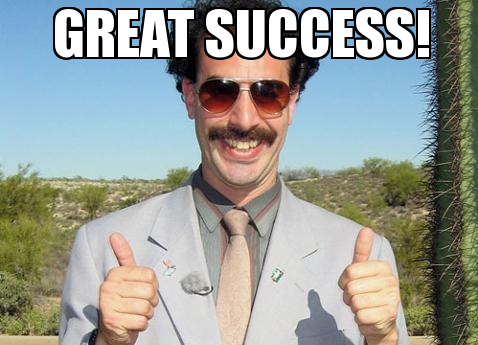
Today, the new Borat movie comes out (and I cannot wait), so the photo above is pretty appropriate. Fundraising metrics are a great measure of success, provided that you measure the right things. Last week, I wrote about the Financial Metrics, and this week I will focus on the non-financial metrics, or moves management.
Non-Financial Metrics
These fundraising metrics have a focus on proper moves management. If you are not moving prospects and donors through the journey, you will stagnate (and likely be unsuccessful in raising funds). I will examine some of the more useful key performance indicators below, starting with some great metrics created by my friend, Jason Lewis.
Temperature: Jason often describes the prospect/donor pool as just that. A pool. What proportion of the pool is hot vs. warm vs. cold? There should be some ground rules, whereby everybody agrees to the definition of hot, warm, and cold. But, it should be relatively equal. And the total aggregate of the pool should be around 75. (Many professionals concur that a development officer can only handle 75 accounts effectively.)
Ratios:
- What is the ratio of initial to subsequent visits for a donor/prospect? It should be 1:1. If it is less, then the fundraiser is having issues following up with the donor. Furthermore, this will focus on visits (as opposed to Direct Mail and Events).
- What is the ratio of visits with an ask of the donor to visits without an ask? Again, this should be 1:1. Is the fundraiser able to move the prospect/donor along the giving continuum?
Stewardship
Tours/Visits: Many people have affirmed that seeing is believing, and in the fundraising world, it is no different. Donors want to see the impact of their philanthropy. How many tours or site visits occurred monthly? Obviously, in this COVID-19 era, organizations may have to resort to virtual tours or think outside the box to show impact. It would be best if you were planning these tours to happen monthly (at the minimum).
Thanking: Do your senior staff thank donors personally either with telephone calls or visits? If not, they should. The CEO should be able to know the Top 25 donors to your organization easily and have some familiar relationships with these donors. Some professionals have said that the CEO should be spending 30% of their time in the fundraising arena (not necessarily asking for money, but thanking, meeting, etc.)
Impact Reports: Have you looped back to the donors who supported your initiative to share with them how their donation was used? What was the impact? Did they leverage others to participate? Did it meet the donor’s objectives? If there isn’t feedback, how can you expect that a donor will choose to invest in your organization again? There should be a report delivered within a month of the completion of the initiative.
Volunteers
The Board: While the board may not have a fundraising mandate, they must be seen as active partners in fundraising, so some fundraising metrics will involve them:
- What percentage of the board donate? (It had better be 100%!)
- What percentage of the board attend your events? This can be fundraising events or stewardship events. This number should be pretty close to 100% as well.
- What percentage of the board have made introductions for you to their circles of influence? If this number is low, there may be a few issues: [a] an unwillingness to be involved in fundraising activities (which may require a re-examination of the board’s fiduciary duties) or [b] the board members are not very influential in the greater community. I would argue that most boards are very influential people (that is one reason they were recruited in the first place).
Managing Staff
Top 20 Visits: For every organization that I have worked with, I tracked each fundraiser’s Top 20 Donors for stewardship and cultivation activities. These Top 20 may be the highest donors that the fundraiser is assigned to, or it may be the chairs of the campaigns that the fundraiser is working on. It is also a fluid list — a donor on the Top 20 this year may not necessarily be on the Top 20 next year. There should be a handful of real moves management steps for each.
Retention: I have written about the staff’s life expectancy numerous times over the past few years. (You can find an article here.) It’s scary and sits somewhere between 18 and 36 months. I would always have a running average of the team’s tenure.
In the Office: For most fundraising streams, it is very challenging to raise money from behind a desk — you need to be out in the field, engaging with prospects and donors. A good fundraiser should be spending at least one-third of their time outside of the office (working). With COVID-19, the notion of office work has gone out of the window, so the metric should be replaced with video calls.
Professional Development: A fundraiser should always be learning. The resources out there are quite impressive. Whether it is a conference (virtual or not), a webinar, a book, or an article, the fact remains that there are a plethora of resources available. If your organization doesn’t invest in your staff’s professional development, the staff will inevitably become unsatisfied and start looking for employment elsewhere.
So there you have it. Two weeks of fundraising metrics. I hope that you find some of these useful in your endeavors.
L’chaim!
jack




